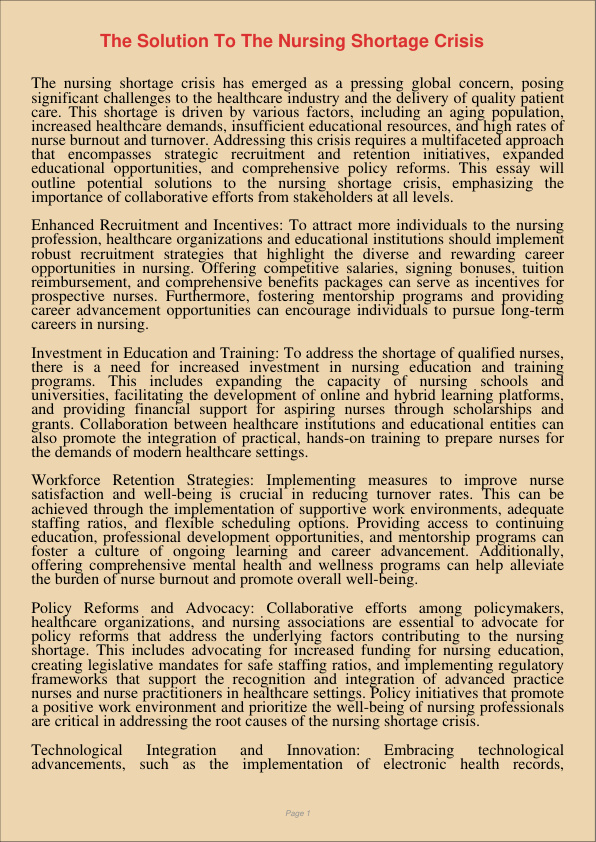The Solution To The Nursing Shortage Crisis
Jan 12, 2024
nursing shortage crisis
solution
Psychology
Gender & Sexual Studies

The nursing shortage crisis has emerged as a pressing global concern, posing significant challenges to the healthcare industry and the delivery of quality patient care. This shortage is driven by various factors, including an aging population, increased healthcare demands, insufficient educational resources, and high rates of nurse burnout and turnover. Addressing this crisis requires a multifaceted approach that encompasses strategic recruitment and retention initiatives, expanded educational opportunities, and comprehensive policy reforms. This essay will outline potential solutions to the nursing shortage crisis, emphasizing the importance of collaborative efforts from stakeholders at all levels.
Enhanced Recruitment and Incentives: To attract more individuals to the nursing profession, healthcare organizations and educational institutions should implement robust recruitment strategies that highlight the diverse and rewarding career opportunities in nursing. Offering competitive salaries, signing bonuses, tuition reimbursement, and comprehensive benefits packages can serve as incentives for prospective nurses. Furthermore, fostering mentorship programs and providing career advancement opportunities can encourage individuals to pursue long-term careers in nursing.
Investment in Education and Training: To address the shortage of qualified nurses, there is a need for increased investment in nursing education and training programs. This includes expanding the capacity of nursing schools and universities, facilitating the development of online and hybrid learning platforms, and providing financial support for aspiring nurses through scholarships and grants. Collaboration between healthcare institutions and educational entities can also promote the integration of practical, hands-on training to prepare nurses for the demands of modern healthcare settings.
Workforce Retention Strategies: Implementing measures to improve nurse satisfaction and well-being is crucial in reducing turnover rates. This can be achieved through the implementation of supportive work environments, adequate staffing ratios, and flexible scheduling options. Providing access to continuing education, professional development opportunities, and mentorship programs can foster a culture of ongoing learning and career advancement. Additionally, offering comprehensive mental health and wellness programs can help alleviate the burden of nurse burnout and promote overall well-being.
Policy Reforms and Advocacy: Collaborative efforts among policymakers, healthcare organizations, and nursing associations are essential to advocate for policy reforms that address the underlying factors contributing to the nursing shortage. This includes advocating for increased funding for nursing education, creating legislative mandates for safe staffing ratios, and implementing regulatory frameworks that support the recognition and integration of advanced practice nurses and nurse practitioners in healthcare settings. Policy initiatives that promote a positive work environment and prioritize the well-being of nursing professionals are critical in addressing the root causes of the nursing shortage crisis.
Technological Integration and Innovation: Embracing technological advancements, such as the implementation of electronic health records, telemedicine, and remote patient monitoring systems, can optimize workflow efficiency and improve the overall quality of patient care. Investing in innovative technologies that streamline administrative tasks and enhance communication between healthcare teams can alleviate the workload for nurses, allowing them to focus more on direct patient care and complex medical interventions.
In conclusion, the nursing shortage crisis demands a comprehensive and collaborative approach that encompasses strategic recruitment and retention initiatives, increased investment in education and training, workforce retention strategies, policy reforms, and the integration of innovative technologies. By addressing the multifaceted challenges facing the nursing profession, stakeholders can work together to create a sustainable and supportive environment that fosters the growth and development of a robust and highly skilled nursing workforce, ultimately ensuring the delivery of high-quality and compassionate patient care.